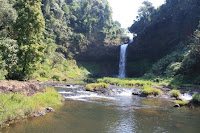 Wat Phra That Bang Phuan in Nong Khai's Ban Don Mu 'village', Phra That Bang Phuan district is one of the region’s most a beautiful Indian-style stupa and one of the most sacred sites within the province.
Wat Phra That Bang Phuan in Nong Khai's Ban Don Mu 'village', Phra That Bang Phuan district is one of the region’s most a beautiful Indian-style stupa and one of the most sacred sites within the province.
It is believed, that some of Lord Buddha’s bones are buried here.
Therefore the place is much respected and worshiped by residents and visitors alike.
Although no one really knows, when the first chedi of Phra That Bang Phuan was built, it is assumed, that it is of the same age as the chedi in Phra Phathom, as it is similar in construction (built with bricks) and style.
 In 1559 King Sayaxettha of Chanthaburi (Viang Chan – aka Vientiane, Laos) extended his capital across the Mekong river and built a taller Lao-style chedi over the original as a demonstration of faith.
In 1559 King Sayaxettha of Chanthaburi (Viang Chan – aka Vientiane, Laos) extended his capital across the Mekong river and built a taller Lao-style chedi over the original as a demonstration of faith.
The nearby Naga pond or 'Sa Phaya Nak' was used in the past to bath the new rulers as an auspicious gesture.
However, heavy rain caused the chedi in 1970 to collapse. Thailand's Fine Arts Department restored the structure in 1976 and 1977.
 The current chedi stands 34.25m high and has several older chedis around it. The lower base of the chedi is 17.2 m wide and consists of five tiers.
The current chedi stands 34.25m high and has several older chedis around it. The lower base of the chedi is 17.2 m wide and consists of five tiers.
This special setting gives the temple of Phra That Bang Phuan an ancient and sacred atmosphere.
Wat Phra That Bang Phuan is 23 km outside Nong Khai direction to Tha Bo.














